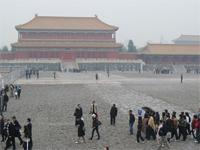China - Revolution in the Air
 Beijing returned to its smog-ridden reality as soon as the Olympic Games finished their successful run in August 2008. Cars hit the road, factories resumed production and cranes were back in action in the often-murky skyline. Yet, in the midst of this seemingly pollution-run amok city is a central government anxious to address climate change throughout China.
Beijing returned to its smog-ridden reality as soon as the Olympic Games finished their successful run in August 2008. Cars hit the road, factories resumed production and cranes were back in action in the often-murky skyline. Yet, in the midst of this seemingly pollution-run amok city is a central government anxious to address climate change throughout China.For the last five years the country’s leaders have stopped talking about economic growth without concern for the environment. They have been keenly aware of the dangers of greenhouse gas emissions and have instituted policies to curb development excesses of the past. In fact China plans to reduce its energy intensity by 20 percent by 2010 and to almost double renewable energy to 15 percent of total generation by 2020, according to the Climate Group, a non-profit dedicated to advance business and government leadership on climate change.
"Significant actions to improve energy efficiency are already under way. China is now showing some of the strongest growth rates in the low carbon industries that reduce climate impacts of any country in the world," write Steve Howard and Changhua Wu of Climate Change in the environmental report, China’s Clean Revolution. China now ranks second in absolute dollar amounts invested in renewable energy - $12 billion in 2007 - second only to world leader Germany.

First, China has placed a heavy emphasis on low-carbon power. It is the world’s second leading solar cell manufacturer with more than 400 companies, some posting annual growth rates greater than 100 percent. Its wind energy industry ranks fifth in the world, behind Germany, the United States, Spain and India. Experts predict that China’s wind capacity of 6 GW in 2008 could reach 100 GW in 2020. And the country’s construction of new coal power plants is relying exclusively on the most energy efficient technology available.
Second, China now requires strict environmental guidelines on new buildings and consumer products. Since 2006 all new office towers or apartment buildings have to reduce their energy consumption by 50 percent from the current Chinese average. The figure rises to 65 percent for those built in wealthy Beijing and Shanghai. All government offices must now keep air conditioning no lower than 26 C (79 F) in the summer months and no higher than 20 C in the winter months (64 F). Consumer appliances, such as refrigerators and washing machines, must meet energy efficiency standards and be labeled as such. The Lawrence Berkeley National Laboratory thinks these standards will allow China to avoid 100 million metric tons of CO2 emissions per year.
Finally, China has modified its transport policy. Not only has the Ministry of Finance increased taxes on gas-guzzling SUVs, but new automobiles now have a 36.7 miles-per-gallon fuel economy standard, higher than in the United States, Canada and Australia. Entrepreneurs have also been encouraged to build electric bicycles in a country where old-fashioned two-wheelers once ruled city streets. There are now 60 million of these green "e-bikes" across China, of which a third were produced in 2007.
"By doing that, not only are they rapidly expanding their economy, they’re creating the brain power and the technology infrastructure they need to address and solve their environmental problems coming up," said Duke Energy chief executive Jim Rogers during a speech at the World Affairs Council of Charlotte in North Carolina.
Yet challenges remain. Even if China’s 1.3 billion people doubled their current renewable energy consumption by 2020, as decreed by the government, the Climate Group estimates that this success would be overshadowed by a doubling of energy demand during the same period. And environmentally-friendly energy supplies may not come quickly. Demand for electricity, for instance, grew by 14.4 percent in 2007. Yet solar technology provides less than 0.2 percent of China’s total electricity needs.
Water pollution is also a cause for concern. Over half of China’s seven main rivers, according to the World Bank, are deemed unsafe for human consumption. And the increasingly populated cities of China are running out of landfill. The 50 municipal solid waste incinerators that exist today – those that produce electricity from garbage – will have to see their numbers rise significantly and soon.
Institutional brakes may also play a factor in slowing the renewable energy bandwagon. Many environmental resources are public property and it is hard to find who actually owns them, according to Ma Jung, director of the Beijing-based Institute of Public and Environmental Affairs. And when they are used at will, he says, their overexploitation becomes inevitable. There are also learning hurdles to overcome. When the Norwegian Pollution Control Authority tried to train pollution monitors in Guizhou province, it found that cozy relationships between some inspectors and local administrators made the enforcement of pollution bylaws difficult to implement.
Still, China’s profit-driven entrepreneurs have such a drive to succeed that they are likely to overcome these obstacles. They are helped by lenders who see that replacing inefficient technology is a profitable and growing market. They are also helped by the government which sees the green revolution as a means of creating jobs and increasing energy security. A stark contrast to the environmental criticisms the government endured during the Olympic Games.
China reshaped its national image by using the sporting event to turn the country’s capital into one of the 21st century’s most advanced centers of culture, economic power and geo-political influence. No one expects miracles, but in a country where one-fifth of humanity lives, any change remains significant.For More Information: Reuters
You can return to the main Market News page, or press the Back button on your browser.

